Un itinerario memorabile che si snoda all’interno dell’ampia mole della Cattedrale di Siena con il Museo, la Cripta, il Battistero e l’Oratorio di San Bernardino alla scoperta dell’animo umano e delle verità della fede svelate attraverso la cultura e l'arte.
Il magnifico complesso dell’Opera Metropolitana in Siena comprende una serie di monumenti tra i più significativi nel panorama artistico europeo. La cattedrale ne rappresenta senza dubbio il fulcro dal quale si diparte ogni ulteriore approfondimento, m... more
Il magnifico complesso dell’Opera Metropolitana in Siena comprende una serie di monumenti tra i più significativi nel panorama artistico europeo. La cattedrale ne rappresenta senza dubbio il fulcro dal quale si diparte ogni ulteriore approfondimento, ma sono parte determinante del complesso anche la Cripta, il Battistero e il Museo dell’Opera inseriti nella stessa ampia mole costituita dal “Duomo Vecchio” e dal “Duomo Nuovo”. Nella cattedrale si conservano numerose sculture, capolavori dell’arte di ogni tempo, realizzati da alcuni fra i massimi artisti: Nicola Pisano ha scolpito il celebre Pergamo, a Donatello spetta un’intensa effigie bronzea di San Giovanni Battista conservata nell’omonima cappella; Michelangelo ha eseguito quattro statue inserite nelle nicchie dell’Altare Piccolomini; con l’età barocca il patrimonio plastico del Duomo viene arricchito da due statue del Bernini nella Cappella del Voto, uno dei luoghi più rappresentativi del culto. Nella Libreria Piccolomini, sul fianco sinistro del Duomo, si possono ammirare i celebri affreschi del Pinturicchio raffiguranti la biografia dell’umanista Enea Silvio Piccolomini, papa Pio II, la sfavillante volta a grottesche, il gruppo marmoreo delle Tre Grazie, copia di epoca romana da originale ellenistico, i preziosi codici del XV secolo conservati nelle vetrine. A al di là dei numerosi capolavori di ogni epoca, l’opera per più versi eccezionale è il pavimento realizzato con la tecnica del graffito e del commesso marmoreo, frutto di un programma di ispirazione classica e religiosa, che si è realizzato attraverso i secoli, a partire dal Trecento fino all’Ottocento. La visita prosegue nella Cripta, che conserva un ciclo “alle origini” della pittura italiana, e nel Battistero che contiene almeno un’opera straordinaria del primo Rinascimento, il celebre Fonte Battesimale. Le formelle in bronzo dorato, con Storie di San Giovanni Battista, sono state infatti concepite da artisti quali Jacopo della Quercia, Lorenzo Ghiberti e Donatello. La suggestiva decorazione delle volte affrescate dal Vecchietta illustra gli articoli del Credo che designano la professione di fede, richiesta al catecumeno per l’ammissione al Battesimo. Nel Museo dell’Opera, che da oltre cento anni custodisce le preziose opere d’arte che provengono dal Duomo, a rappresentarne la memoria storico-artistica, devozionale e religiosa, è possibile ammirare la Vetrata e la grande pala d’altare trecentesca raffigurante la Maestà di Duccio di Buoninsegna, capolavoro della pittura medievale europea, le statue di Giovanni Pisano che decoravano la facciata del Duomo, la Madonna del Perdono di Donatello e la Rosa d’oro del Bernini oltre a numerosi capolavori pittorici di scuola senese e un’importante collezione di oreficerie e tessili. Salendo sul Facciatone sarà possibile ammirare la sorprendente veduta della città di Siena e della sconfinata campagna toscana circostante. Fa parte del complesso anche il cinquecentesco Oratorio di San Bernardino, con il ciclo di affreschi con la storia della vergine che accoglie in alcuni ambienti attigui il Museo Diocesano di Arte Sacra ove è conservata la celebre Madonna del Latte di Ambrogio Lorenzetti.
lessCattedrale, Libreria Piccolomini, Museo dell'Opera,
Panorama dal Facciatone, Cripta, Battistero:
dal 1° aprile al 31 ottobre
dalle ore 10:00 alle ore 18:00
dal 1° novembre al 31 marzo
dalle ore 10:30 alle ore 17:30
nei giorni festivi la Cattedrale apre alle ore 13:30
Biglietteria per cambio Voucher:
Piazza Duomo, 7 - 53100 Siena
Duomo, Museo dell'Opera
e Biblioteca Piccolomini:
Piazza del Duomo
Cripta:
Scalinata di San Giovanni
Battistero:
Piazza San Giovanni
Oratorio di San Bernardino:
Piazza San Francesco
In auto:
Da nord: A1 uscita “Firenze Impruneta”, quindi Superstrada Firenze/Siena (40 min.).
Da sud: A1 uscita “Valdichiana”, quindi raccordo Bettolle-Siena (2h 30min.)
Il Duomo si trova all’interno del Centro Storico della città, non è pertanto consentito raggiungerlo direttamente in auto. Arrivando in auto è consigliabile uscire a Siena Ovest e raggiungere il Parcheggio Duomo, oppure uscire a Siena Sud e raggiungere il Parcheggio Il Campo. Per info: www.sienaparcheggi.it
In treno:
Visita il sito www.trenitalia.com per conoscere gli orari dei collegamenti da Roma, Firenze, Pisa e Grosseto. La Stazione di Siena è in piazza Carlo Rosselli, a circa 2 km dal Centro Storico. Dalla Stazione Ferroviaria al centro il tempo di percorrenza in Bus è di circa 5 minuti (per info: orario autobus urbani).
In autobus:
Collegamenti dalle grandi città come Roma e Firenze.
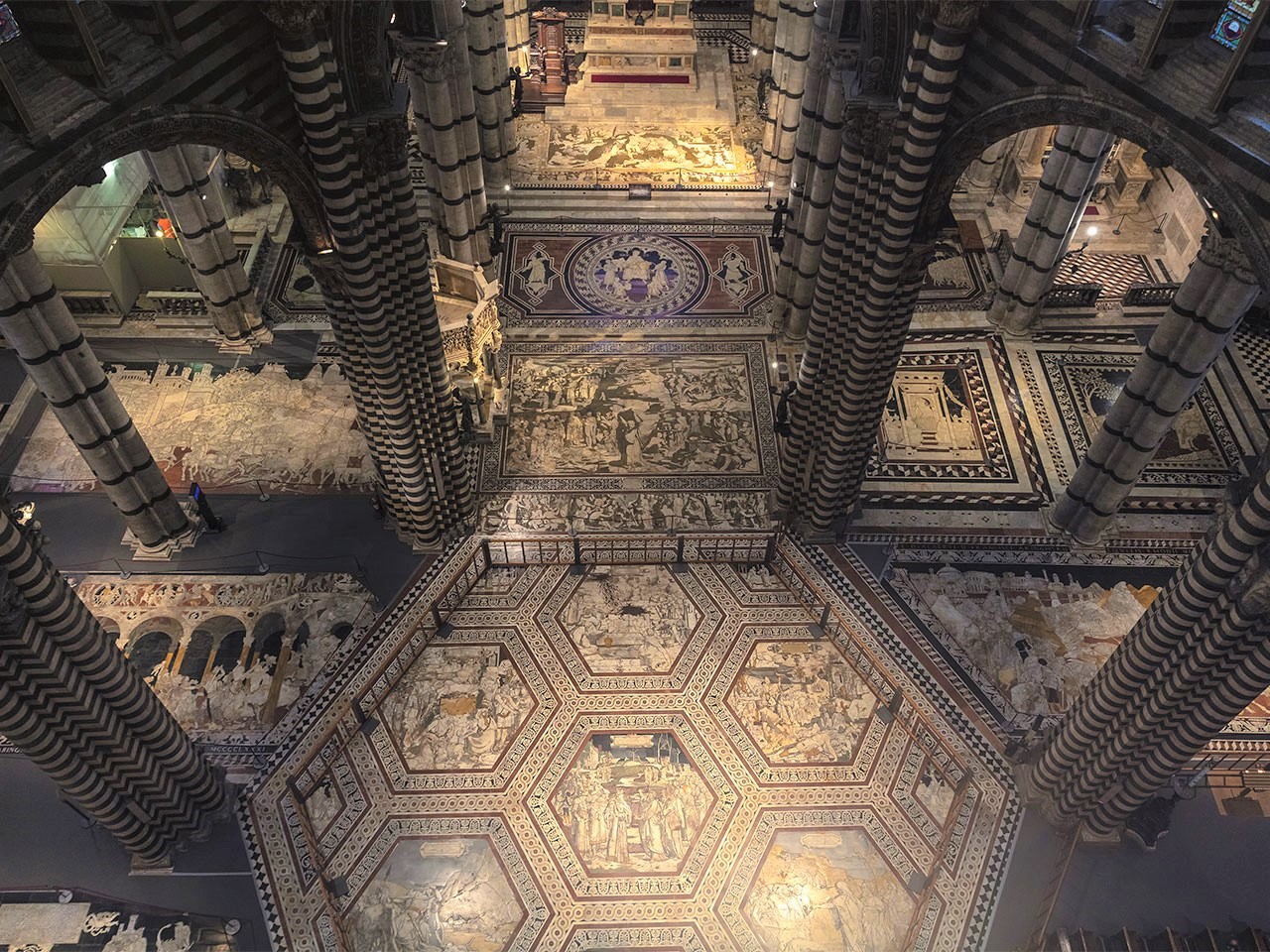
Though the Cathedral of Siena preserves a number of artistic masterpieces, perhaps the most exceptional masterpiece of all is the artistic floor, which took 5 centuries to complete, having been created between the fourteenth and the nineteenth century: the artistic floor was created utilizing the opus sectile technique, as the result of a program of classical and religious inspiration.
The conceptual program of the various artists was imprinted in the floor by means of the opus sectile technique. In the three naves the themes relate to classical and pagan antiquity: The she-wolf nursing the twins; Hermes trismegistus, the founder of human wisdom; the ten Sibyls who gave their oracular responses in various parts of the world; the philosophers who rejected wealth in order to better understand the depth of the human soul in its relationship with divinity. In the transept and in the choir the themes touch on the history of the Jewish people together with the events of salvation history which finds its fullfillment in Christ, who is constantly evoked but never explicitly represented in the artistics panels of the floor, seeing He is present on the altar itself during the Eucharistic celebration. It is there that the whole artistic program of the floor converges.
less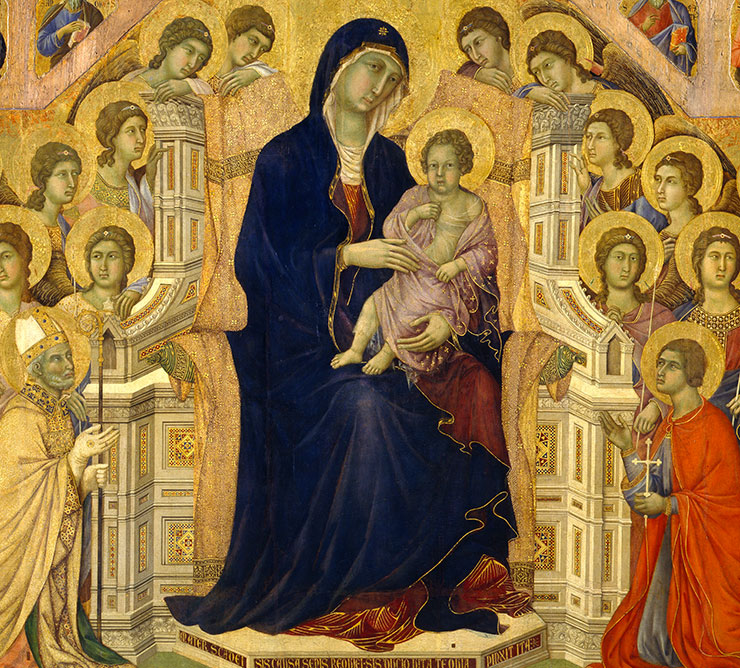
The magnificent altarpiece with Duccio di Buoninsegna's Maestà can be found on the first floor of the Museum, in a nice air-conditioned room. It is an absolute masterpiece of early fourteenth-century Italian painting, and the true charm of the entire collection.
Duccio received the commission for the panel in 1308, and completed it in June 1311. A solemn procession accompanied the piece to its proper place on the main altar of the cathedral. On the front, Our Lady is seated on a throne, and surrounded by a court of angels and saints. She is the perfect image of the mysterious reality of the Church. In fact, like the Church, Mary, though fully human, carries the divine mystery of the Son of God in her womb, to whom she birth and who she offers to those men who seek the path of their destiny. On the back, the Passion of the Christ is told in twenty-six squares. A predella and a crown completed the work and were painted on both sides. The predella, placed below the central panel, contained the Stories of Jesus' infancy on the back, and Episodes from his public ministry on the front. The crown depicted Stories from the Life of Our Lady on the back, and Stories of Our Lord after the resurrection on the front.
less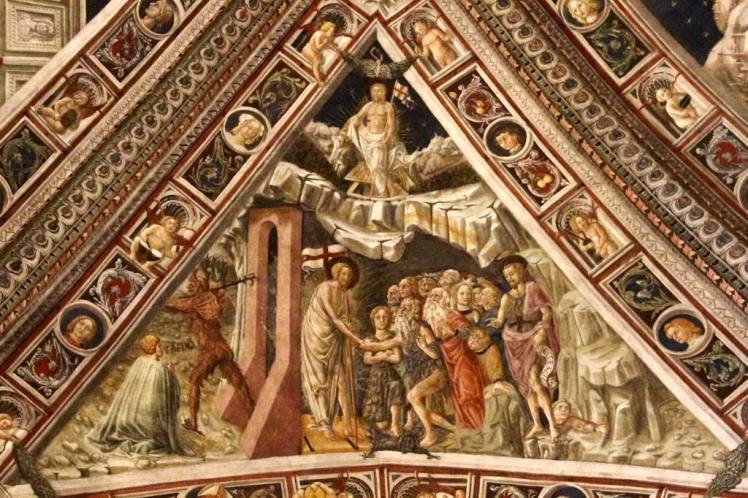
In 1450, Lorenzo di Pietro, known as "il Vecchietta", was commissioned to decorate the vaults of the Sienese Baptistery, continuing the work already set up by the Bolognese painter Agostino di Marsiglio. The church has a rectangular layout, divided into three naves by two substantial pillars; each nave includes two bays with rib vaults. The figures of the Apostles appear in those near the entrance, while the Articles of the Credo are represented in the sections of the ribbed vaults adjacent the back wall.
There are twelve scenes, four for each bay, which are in succession in an anticlockwise fashion. Abstraction and metaphysical rigor characterize the various scenes, including: the Ascension (sixth section), where Christ, placed frontally in the fiery almond, is seated for eternity in the high heaven; the descent of the Holy Spirit (eighth section) where the dove is submerged by a beam of light that radiates on the host raised in the chalice; the allegory of the Catholic Church (ninth section) in which the pontiff rests on St. Peter half-lying on the ground. With his left hand, the pope hands over the keys to the founder of the Catholic Church while with the other hand he administers baptism, an instrument of salvation, to a catechumen immersed in the water of a gilded bronze fountain, in the presence of a believer kneeling with hands joined in prayer, in the act of uttering the word "I BELIEVE", as happens in each of the other sections.
less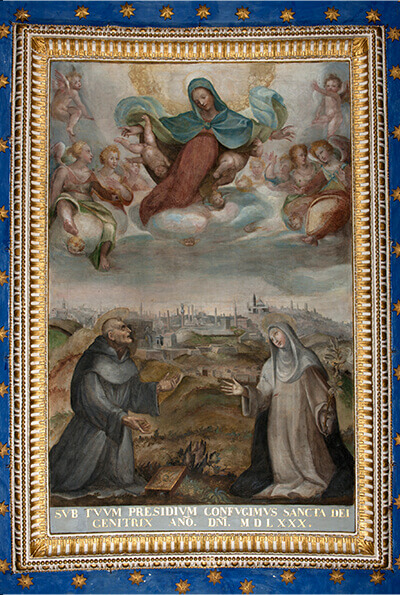
The architectural structure of the Oratory of San Bernardino dates back to the late medieval period. It was completely renovated during the sixteenth century. It is a very suggestive place, one of the most interesting museum spaces in Siena, as it is able to offer an overall overview of the Sienese pictorial production from the thirteenth century onward. The Diocesan Museum of Sacred Art is situated in some adjacent spaces.
The building, originally intended to house the Confraternity of the Virgin Mary and of Saint Francis, was dedicated in the sixteenth century to Saint Bernardino. Friar Bernardino Albizzeschi often held fervent sermons in the town square in front. He was canonized in 1450. The entrance of the Oratory consists of an elegant travertine portal. Beyond the entrance, the environment is filled with lunettes which were frescoed between the end of the sixteenth and seventeenth centuries and which depict episodes related to the miracles in the life of Saint Bernardino. The splendid chapel of the upper oratory dedicated to Saint Mary of the Angels constitutes the heart of the museum: it was completely frescoed in the early sixteenth century by Domenico Beccafumi, Giovanni Antonio Bazzi known as Sodoma, and Girolamo Pacchia. The iconographic program present in the scenes that unfold along the walls of the oratory, with Stories from the life of Our Lady, aims to celebrate the Assumption of the Virgin Mary in body and soul.
less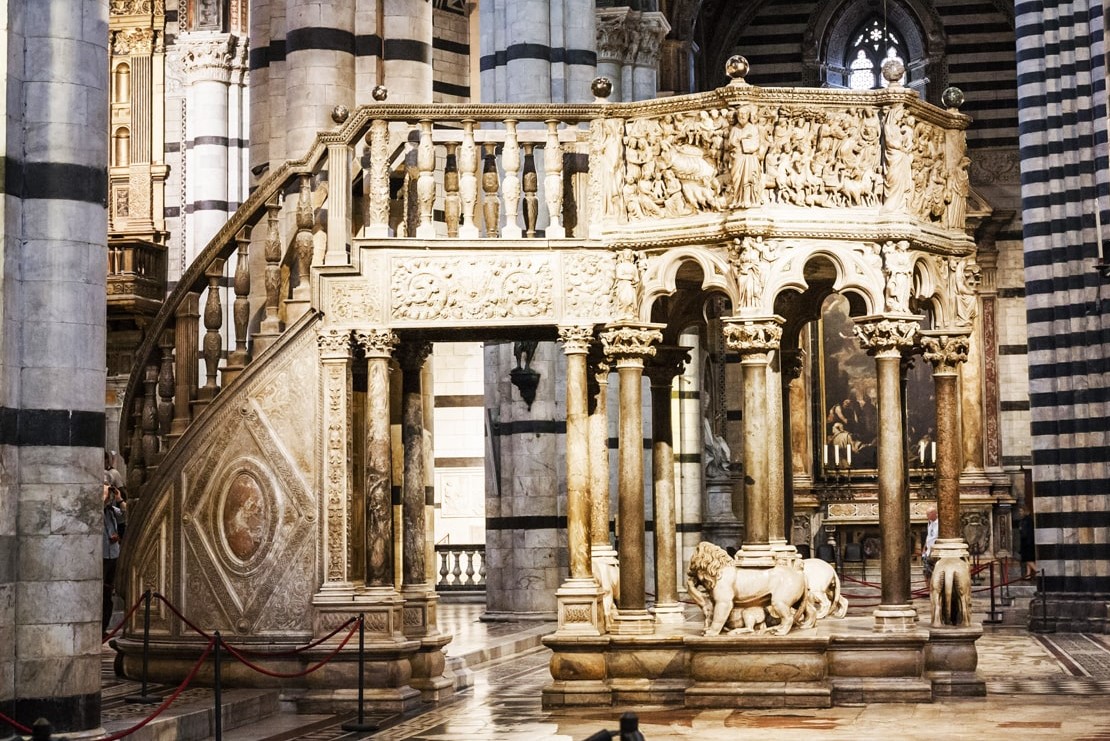
The octagonal pulpit, sculpted by Nicola Pisano between the years 1265 and 1268, was used to announce the Resurrection of Jesus and to proclaim his Gospel during the eucharistic celebrations.
The aim of his scheme of iconography was to illustrate Christian doctrine as regards redemption, and is outlined in three levels: on the lower level, next to lions and lionesses, the Liberal Arts and Philosophy through which man rises to God are depicted. Following, we have the Virtues, the Evangelists and the Prophets, inserted in the corners and plumes of the octagon. The coming of Christ who saved humanity is illustrated in the tiles of the gallery. The following scenes are depicted, one after the other: the Visitation and the Nativity; the Journey and the adoration of the Magi; the Presentation in the Temple and the Flight into Egypt; the Massacre of the Innocents; the Crucifixion; the Final judgement. The iconography of the reliefs follow a scheme based on the structure of the Gospels: we have in front of us, in fact, a Gospel carved into stone.
less